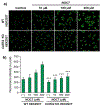Rational Design of a Dual-Reactivity-Based Fluorescent Probe for Visualizing Intracellular HSNO
- PMID: 31479578
- PMCID: PMC6814498
- DOI: 10.1002/anie.201908950
Rational Design of a Dual-Reactivity-Based Fluorescent Probe for Visualizing Intracellular HSNO
Abstract
Thionitrous acid (HSNO), the smallest S-nitrosothiol, is emerging as a potential key intermediate in cellular redox regulation linking two signaling molecules H2 S and NO. However, the chemical biology of HSNO remains poorly understood. A major hurdle is the lack of methods for selective detection of HSNO in biological systems. Herein, we report the rational design, synthesis, and evaluation of the first fluorescent probe TAP-1 for HSNO detection. TAP-1 showed high selectivity and sensitivity to HSNO in aqueous media and cells, providing a useful tool for understanding the functions of HSNO in biology.
Keywords: S-nitrosothiols; biosensors; fluorescent probes; hydrogen sulfide; imaging agents.
© 2019 Wiley-VCH Verlag GmbH & Co. KGaA, Weinheim.
Figures





References
-
- Williams DLH, Acc. Chem. Res 1999, 32, 869.
-
- Singh RJ, Hogg N, Joseph J, Kalyanaraman B, J. Biol. Chem 1996, 271, 18596. - PubMed
Publication types
MeSH terms
Substances
Grants and funding
LinkOut - more resources
Full Text Sources
Other Literature Sources
Research Materials
Miscellaneous

